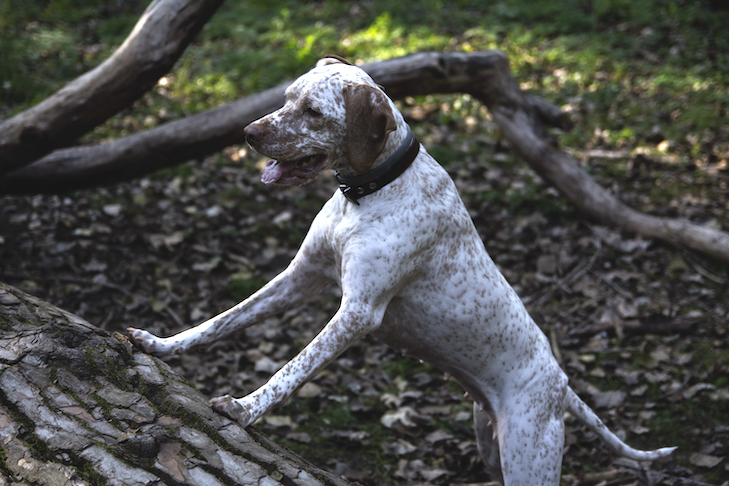
Dogs are hard to resist when they glance up at us with their large, soulful eyes. It’s natural to believe that their perspective on the world is similar to our own. However, in reality, it isn’t the case.
Dogs can only distinguish between yellows and blues, perceive things at considerably shorter distances (this may explain why your dog howls at you in the driveway), and have a far less developed sense of depth than humans (30-60 degrees compared to 140 degrees in humans). Nonetheless, canines are much superior to humans when it comes to night vision.
According to the Merck Veterinary Manual, canine eyes are quite similar to human eyes in terms of their function. The eye is a dynamic organ that automatically changes its aperture to concentrate on both nearby and distant things. It generates constant visuals, which are sent to the brain in a flash.
Both canine and human vision are affected by a number of things.
- Perceptual Angle
- Observable Area
- The ability to gauge distances in three dimensions
- Dogs normally have 20/75 eyesight.
- Ability to discern color and shape, as well as light and motion
Our pets’ ancestry as descended from wild canines provides a foundation for understanding how dogs sight in the dark. Crepuscular, from the Latin twilight, describes the hours of greatest activity for wild canines. In order to find and catch their food or breakfast, they had to be able to see in low light. Dogs have maintained their ability to sight in the dark even as they have adapted to life in the sunshine.
Eye Anatomy in Dogs

If you walk your dog at night, you may have noticed that he reacts faster to potential dangers than you do. Dogs have greater night vision and are able to detect movement and light in low-light conditions, which complements their enhanced sense of smell.
The large number of rods, which respond to dim light, in the retina of their eyes help them out. The rods in your eyes let you see in the dark by picking up on light at low intensities. Cones, which are sensitive to color and are essential for visual performance in daylight, predominate in the human retina.
However, a canine’s tapetum lucidum is his hidden weapon for night vision. A mirror inside the eye, the tapetum is a layer of reflective cells located behind the retina that reflects incoming light and allows the retina to process it a second time. This improves the dog’s capacity to see in dim light and amplifies nearby items for easier detection. The tapetum is not present in human eyes.
Flicker Fusion Frequency (FFF), the rate at which successive frames of light are fused into a single, smooth image, also affects an animal’s night vision. If a species can rapidly adapt to its surroundings, it will have a high FFF. According to AKC chief veterinary officer Dr. Jerry Klein, “dogs have a higher flicker fusion threshold than humans,” meaning that a television screen that appears to show continuous motion to humans may appear to flicker to a dog. This heightened ability to see flickering light also helps dogs detect smaller movements in the dark.
Depending on the breed, the majority of a dog’s eyes are located on the side of its head. This offers it a broader field of vision than the average person and makes it easier for the animal to swiftly take in its surroundings.
What Causes the Iridescence of a Dog’s Eyes?
You’ve probably noticed that some photographs of dogs at night have an unsettling, greenish-yellow glow in their eyes when the subject is illuminated by a headlamp or a flashlight (caused by the camera flash). The tapetum is the source of what you’re seeing.
When light is reflected off of the tapetum, its color might shift from green to blue to orange to yellow. The American College of Veterinary Ophthalmologists reports that this coloring often changes within the first three months of a pet’s existence.
The tapetum is not present in certain dogs, most notably those with blue eyes. Therefore, the red blood veins at the rear of the dog’s eyes cause the eyes to appear red in photographs, rather than the greenish reflection from the tapetum.
For what reason should we worry about what canine eyes can detect?
Understanding the visual processes and environmental influences on canines and human vision requires knowledge of what and how canines perceive. As the authors of a recent paper in the Journal of Eyesight explained, this knowledge also aids in the breeding and training of working dogs for activities that need specialized vision.
A Labrador Retriever, for instance, must visually monitor a field or body of water and mark the spots where birds land. When herding sheep, Border Collies must be alert to even the slightest of motions. To keep their human companions safe, guide dogs need sharp peripheral vision.
Dog Vision is an online resource that provides a visual representation of the night vision a dog has by using an image processing tool that lets visitors submit a picture and alter it to demonstrate the visual differences between a human’s and a dog’s perspective.